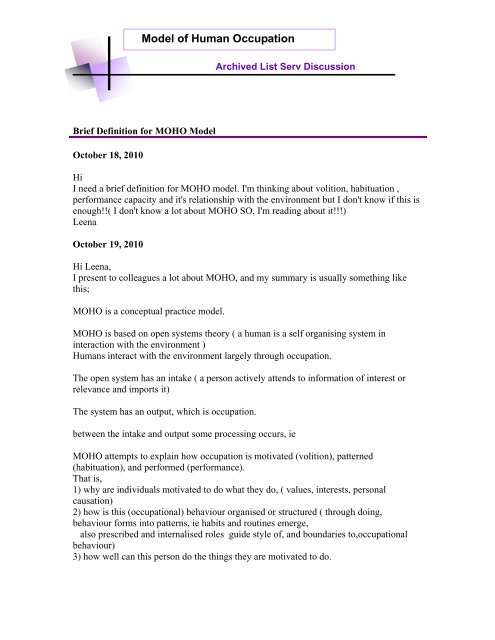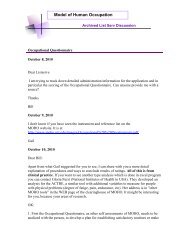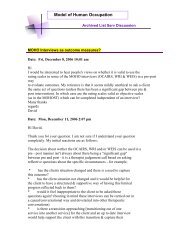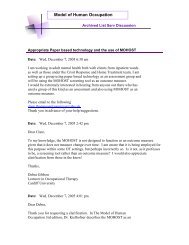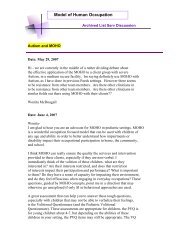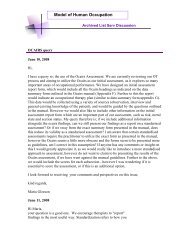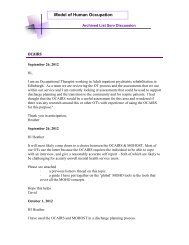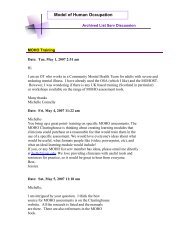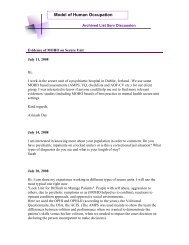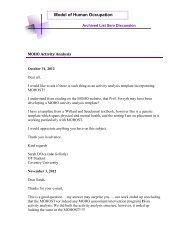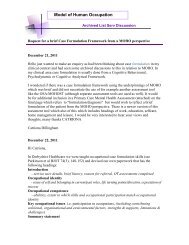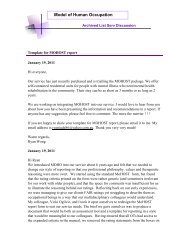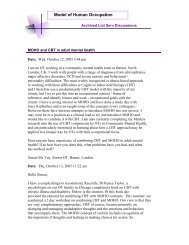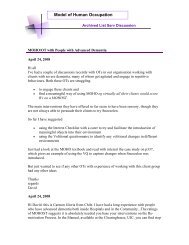Brief Definition of MOHO model
Brief Definition of MOHO model
Brief Definition of MOHO model
Create successful ePaper yourself
Turn your PDF publications into a flip-book with our unique Google optimized e-Paper software.
Model <strong>of</strong> Human Occupation<br />
Archived List Serv Discussion<br />
<strong>Brief</strong> <strong>Definition</strong> for <strong>MOHO</strong> Model<br />
October 18, 2010<br />
Hi<br />
I need a brief definition for <strong>MOHO</strong> <strong>model</strong>. I'm thinking about volition, habituation ,<br />
performance capacity and it's relationship with the environment but I don't know if this is<br />
enough!!( I don't know a lot about <strong>MOHO</strong> SO, I'm reading about it!!!)<br />
Leena<br />
October 19, 2010<br />
Hi Leena,<br />
I present to colleagues a lot about <strong>MOHO</strong>, and my summary is usually something like<br />
this;<br />
<strong>MOHO</strong> is a conceptual practice <strong>model</strong>.<br />
<strong>MOHO</strong> is based on open systems theory ( a human is a self organising system in<br />
interaction with the environment )<br />
Humans interact with the environment largely through occupation.<br />
The open system has an intake ( a person actively attends to information <strong>of</strong> interest or<br />
relevance and imports it)<br />
The system has an output, which is occupation.<br />
between the intake and output some processing occurs, ie<br />
<strong>MOHO</strong> attempts to explain how occupation is motivated (volition), patterned<br />
(habituation), and performed (performance).<br />
That is,<br />
1) why are individuals motivated to do what they do, ( values, interests, personal<br />
causation)<br />
2) how is this (occupational) behaviour organised or structured ( through doing,<br />
behaviour forms into patterns, ie habits and routines emerge,<br />
also prescribed and internalised roles guide style <strong>of</strong>, and boundaries to,occupational<br />
behaviour)<br />
3) how well can this person do the things they are motivated to do.
Additionally through acting in the world, we receive feedback from what we do, and have<br />
thoughts and feelings about it, which is taken<br />
back into the system (intake), creating change over time.<br />
The key to understanding the <strong>model</strong> is to understand that all the components described<br />
above are in a constant dynamic interaction with each other.<br />
"Resonating", as Garry Kielh<strong>of</strong>ner said.<br />
And when any part <strong>of</strong> it changes ( process skill, environment, values, roles etc ) the<br />
whole dynamic will shift. sometimes this is not in a healthy<br />
direction, which is occupational dysfunction, or a state <strong>of</strong> disorder within the system.<br />
Any definition should include i think, open system, self organisation, motivation, pattern,<br />
performance, environment, change over time through doing,<br />
dynamic interaction, self-organising, and lastly occupation.<br />
Difficult to do in a few words. My patients articulate it better than anyone, and they don't<br />
even know the theory!<br />
Hope this helps.<br />
regards<br />
Tim james<br />
October 19, 2010<br />
Hi Leena<br />
The definition I use (and probably stole!) is:<br />
"a way <strong>of</strong> understanding how human occupation is motivated (VOLITION), organised<br />
(HABITUATION), performed (PERFORMANCE) and influenced by the environment"<br />
regards<br />
David<br />
October 19, 2010<br />
Dear Leena,<br />
Thanks for your e-mail……please find below a short and then a longer overview <strong>of</strong><br />
<strong>MOHO</strong>,<br />
Short definition: <strong>MOHO</strong> explains how meaningful daily activities (occupations) are<br />
motivated, organized into everyday life patterns, and performed in the context <strong>of</strong> the<br />
environment.
Long definition: <strong>MOHO</strong> provides a framework (or <strong>model</strong>) for occupational therapist to<br />
understand how to use daily activities therapeutically to support people’s health. It seeks<br />
to explain how meaningful daily activities are motivated, patterned, and performed.<br />
First motivation….<strong>MOHO</strong> supports an understanding <strong>of</strong> how people are motivated and<br />
make choices for doing the activities that fill their lives. To explain human motives for<br />
daily activities, <strong>MOHO</strong> answers critical questions e.g., what accounts for the individual<br />
differences in what people want and choose to do?, why is one bored by an activity that<br />
another enjoys?, why does one person find valuable what another considers a waste <strong>of</strong><br />
time?<br />
Secondly, <strong>MOHO</strong> supports an understanding <strong>of</strong> why everyday life is made up <strong>of</strong><br />
recurrent patterns <strong>of</strong> behaviour in familiar physical and social environments. People<br />
behave in similar ways over and over again, they follow similar patterns <strong>of</strong> time use, and<br />
they do things in pretty much the same way they did them before. A great deal <strong>of</strong> human<br />
life simply follows a routine pattern <strong>of</strong> daily activities. These routine patterns support the<br />
fulfilment <strong>of</strong> role responsibilities….being mothers, friends, workers, sons….…giving us<br />
a sense <strong>of</strong> who we are.<br />
Finally, <strong>MOHO</strong> supports an understanding <strong>of</strong> how people perform daily activities.<br />
Whether it is lifting food to one's mouth or playing first violin in an orchestra, humans<br />
demonstrate fine and coordinated movements when they do things. When performing<br />
daily activities, people also anticipate, plan, observe what happens, make adjustments and<br />
decide what to do next. Whether it is getting one's clothes washed, folded, and stored<br />
away in the closet or designing & assembling a car, people show an uncanny ability to<br />
figure out how to get something done. People also participate and communicate with<br />
others. From simple conversation to participation in a scientific discussion - the ability to<br />
coordinate action and share information is part <strong>of</strong> engaging in everyday activity.<br />
<strong>MOHO</strong>, therefore, explains how daily activity is motivated, organized into everyday life<br />
patterns, and performed in the context <strong>of</strong> the environment.<br />
<strong>MOHO</strong> also provides support for occupational therapist to use this theory in practice.<br />
There are assessments (which support therapists to ask questions to understand people’s<br />
lack <strong>of</strong> engagement in daily activity) & intervention protocols (which support therapist,<br />
use daily activities therapeutically to impact health).<br />
Hope this is helpful,<br />
Warm wishes,<br />
Pr<strong>of</strong> Forsyth<br />
October 19, 2010<br />
Leena, this is what I use.
"The Model <strong>of</strong> Human Occupation is the oldest conceptual practice <strong>model</strong> <strong>of</strong><br />
Occupational Therapy which is based on occupation and centered on the client. It<br />
explains how occupational participation emerges, occurs and changes at any given time<br />
and context and through the life span, integrating the motivational and the organizational<br />
aspects <strong>of</strong> performance and routines, the mind body capacities and the environmental<br />
impact in a dynamic and constant interaction which leads on a unique participation in<br />
occupations, occupational identity and occupational competence. <strong>MOHO</strong> provides a<br />
theoretical framework, a therapeutic reasoning process, an evaluation process with<br />
correspondant assessments, and an intervention process with correspondant protocols for<br />
intervention, strategies and program development guidelines. It also provides a strong<br />
body <strong>of</strong> literature supporting evidence based practice. Because is a solid internationaly<br />
researched client centered and occupational based <strong>model</strong> it can be applied with a wide<br />
variety <strong>of</strong> populations <strong>of</strong> different cultures and social realities, ages, and needs, including<br />
people with and without disabilities."<br />
I call it the "people´s <strong>model</strong>".<br />
Warm big hug for you Leena and for all<br />
Carmen Gloria de las Heras, MS, OTR<br />
Chile<br />
October 19, 2010<br />
HI Leena, I am a pr<strong>of</strong>essor at A.T. Still University and my students are going to attempt<br />
to answer your question:<br />
<strong>MOHO</strong> takes a holistic approach working from top down beginning with the actual<br />
occupation. <strong>MOHO</strong> considers human beings to be an open system consisting <strong>of</strong><br />
volitional, habituation, and performance capacity and considers how these three aspects<br />
interact with each other and the environment. You may want to explore systems theory<br />
because <strong>MOHO</strong> is based on it ( Bertalanffly). The O.T. practice framework is strongly<br />
influenced by <strong>MOHO</strong>.<br />
Volition is primarily concerned with motivation. Habituation refers to habits and roles.<br />
Performance capacity is the ability to do things depending on physical and mental<br />
components.<br />
We hope this helps!<br />
Sincerely,<br />
Mary<br />
October 19, 2010
Hi Lena,<br />
Here's a real quickie definition:<br />
"<strong>MOHO</strong> is a concept that explains how a person uses their will, drill and skill to interact<br />
with the environment."<br />
(Will, drill and skill being Volition, Habituation and Performance Capacity)<br />
Hope it helps!<br />
John<br />
October 19, 2010<br />
Dear Tim,<br />
Lovely to hear from someone in New Zealand…..my twin brother lives in NZ now!<br />
I liked your focus on systems thinking to help us explain how meaningful daily activities<br />
(occupations) are motivated, organized into everyday life patterns, and performed in the<br />
context <strong>of</strong> the environment.<br />
Update below with an example…..<br />
Dynamical systems**<br />
<strong>MOHO</strong> was originally based on concepts <strong>of</strong> open systems and general systems theory. As<br />
these ideas were expanded and revised in more recent dynamical systems theory, the use<br />
<strong>of</strong> systems concepts in <strong>MOHO</strong> has evolved also.<br />
What does a dynamical system look like in our practice?<br />
Let’s look at a part <strong>of</strong> Bob’s occupational life…..<br />
A highly organized process unfolds as people go about their everyday occupations.<br />
Consider, for example, Bob doing his morning routine <strong>of</strong> getting washed, groomed, and<br />
dressed. After getting out <strong>of</strong> bed, he puts on some c<strong>of</strong>fee, takes a shower and shaves and<br />
then puts on his work clothes. During much <strong>of</strong> this time Bob is thinking about an<br />
upcoming fishing trip that he is taking on the weekend with his best friend, Fred. During<br />
his drive to his job where he is the boss <strong>of</strong> a plumbing team, he plans how the team will<br />
finish up the job they have been working on. As he pulls into his workplace, he calls<br />
Fred to remind him to buy some bait and tackle at the fishing supplies shop.<br />
It is a dynamical system!
Bob is within a dynamical system which explains how he engages in his occupations<br />
…….Bob’s habits (habituation) guide his morning routine and frees him to engage in<br />
motivational (volitional) anticipation <strong>of</strong> the upcoming fishing trip. Similarly, while his<br />
habit (habituation) <strong>of</strong> driving to work unfolds, his awareness <strong>of</strong> the responsibilities<br />
(habituation) <strong>of</strong> his worker role stimulates him to plan the activities <strong>of</strong> the team. During<br />
all this time, Bob’ s physical and mental capacities (performance capacities) are being<br />
called upon as he engages in tying his shoes, watching the traffic as he drives, and<br />
planning an errand for Fred after work. As this small slice <strong>of</strong> Bob’s occupational life<br />
illustrates, occupation always involves an ongoing dynamic interplay <strong>of</strong> volition,<br />
habituation, performance capacity and the environmental context.<br />
Every instance <strong>of</strong> human occupation reflects a unique configuration <strong>of</strong> elements that<br />
together determine what a person’s chooses to do, how that person performs and what is<br />
the outcome <strong>of</strong> the performance.<br />
Dynamical systems are pretty fabby!! and helps us, in very practical ways, support our<br />
clinical reasoning……<br />
Warm wishes,<br />
Pr<strong>of</strong> Forsyth<br />
October 19, 2010<br />
Hi John:<br />
I would like to clarify taht Moho identifies clearly the process <strong>of</strong> occupational change and<br />
development through life in progress getting into occupational identity and competence<br />
and therefore occupational adaptation. The roots <strong>of</strong> Activities Therapy from Mosey<br />
earlier in time, were not really centered on the client in terms <strong>of</strong> its application. She<br />
included activities and characteristic <strong>of</strong> group activities but intervention was determined<br />
by the OT.<br />
Apart from that Anne Mosey presented a book in the eary seventies called THree frames<br />
<strong>of</strong> Reference for Occupational Therapy. Where she included Behaviorism (Operant<br />
Conditioning), Object Relations (psychoanalitical approach) and the recapitulation <strong>of</strong><br />
ontogenesis (also a psychology approach to explain development <strong>of</strong> people with focus in<br />
internal pschological aspects). These three frames <strong>of</strong> references were not based on<br />
occupation, "were cut and paste" from psychology into taht book for OT. They werent at<br />
all centered in the client.<br />
With my best intentions<br />
Carmen Gloria de las Heras, MS, OTR<br />
Chile<br />
October 19, 2010
Thank you John...I am so happy we can intercahnge experiences <strong>of</strong> knowledge and<br />
practice <strong>of</strong> our pr<strong>of</strong>ession. Thank you for understanding my good will on making those<br />
observations..Yes, Anne utilized those theoretical bases in the time <strong>of</strong> the crisis <strong>of</strong> our<br />
Paradigm <strong>of</strong> Occupation, she had a reason to get the pr<strong>of</strong>ession recognized by other<br />
disciplines..She is one <strong>of</strong> the OTs who has worked for defining the configuration <strong>of</strong><br />
knowledge <strong>of</strong> the pr<strong>of</strong>ession. I consider her and Gary to be the two most important<br />
advocates for defining our configuration <strong>of</strong> knowledge <strong>of</strong> OT.<br />
And yes, client centrerdness is more complex and has to be reflected in many actions <strong>of</strong><br />
therapists in practice. Many times, us , clinicians "get to do more than frames <strong>of</strong><br />
references <strong>of</strong>fers us to do", and that is what I always reafirm, as Gary always said,<br />
"knowledge is made with clinicians, theorists, researchers, and most o all with clients".<br />
And that is what I see in your experience, you really went into applying a framework but<br />
you put into that all your convictions that went beyond that explicit knowledge.<br />
All my appreciation and love<br />
Carmen Gloria de las Heras, MS, OTR<br />
Chile<br />
October 22, 2010<br />
Thank you all for your definitions :)<br />
I appreciate your help all<br />
thank you again<br />
leena


